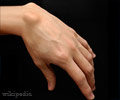An association between Zika virus infection in the womb and a condition known as arthrogryposis, which causes joint deformities at birth has been identified

‘The severe joint deformities in children with Zika virus infection are likely to be of neurogenic origin and not joint conditions themselves.’





Until recently there were no reports of an association between congenital viral infection and arthrogryposis. After the outbreak of microcephaly in Brazil associated with Zika virus, two reports suggested an association, but they did not describe the deformities in detail. This prompted researchers based in Recife, the Brazilian city at the centre of the Zika epidemic, to investigate the possible causes of the joint deformities.They studied detailed brain and joint images of seven children with arthrogryposis and a diagnosis of congenital infection, presumably caused by Zika virus. All children tested negative for the five other main infectious causes of microcephaly: toxoplasmosis, cytomegalovirus, rubella, syphilis, and HIV.
All children showed signs of brain calcification, a condition in which calcium builds up in the brain. The theory is that the Zika virus destroys brain cells, and forms lesions similar to "scars" on which calcium is deposited.
The children underwent high definition scanning of the joints and surrounding tissues, but there was no evidence of joint abnormalities. This led the researchers to say that the arthrogryposis did not result from abnormalities of the joints themselves, but was likely to be of neurogenic origin a process involving motor neurons (cells that control the contraction or relaxation of muscles) leading to fixed postures in the womb and consequently deformities.
They point out that further research is needed with a larger number of cases to study the neurological abnormalities behind arthrogryposis, but suggest that children should receive orthopaedic follow-up because they could develop musculoskeletal deformities secondary to neurological impairment.
Advertisement
Because this is an observational study, no firm conclusions can be drawn about the effect of the Zika virus on arthrogryposis. Nevertheless, the authors suggest that this condition might be related to the way motor neurons carry signals to the unborn baby's muscles, or to problems with arteries and veins (vascular disorders).
Advertisement













